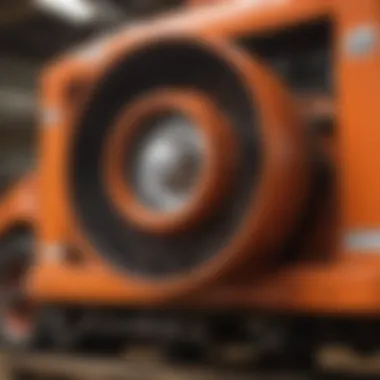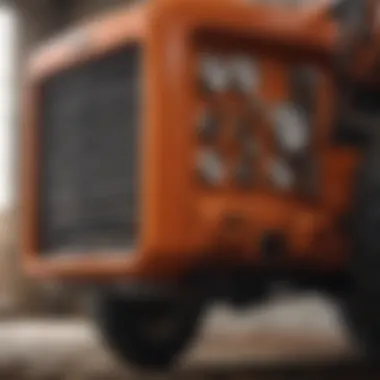Allis Chalmers Radiator: A Comprehensive Overview


Intro
The Allis Chalmers radiator is a crucial component in the world of agricultural machinery. It plays a significant role in maintaining optimal operating temperatures, thereby ensuring the efficiency and longevity of engines. Understanding its design and function can provide operators and enthusiasts with insights that enhance machinery performance.
Overview of the Topic
Definition and Importance
Allis Chalmers radiators are designed to cool the engine while allowing it to work under heavy loads. These radiators are essential for preventing overheating, which can lead to engine damage. Their construction involves various materials, typically metals such as copper and aluminum, chosen for thermal conductivity and durability. Given the rigors of agricultural work, radiators in this context must withstand harsh conditions, including dirty environments and high operational demands.
Current Trends
With advancements in technology, the design and manufacturing of radiators have seen significant changes. Modern Allis Chalmers radiators are now more energy-efficient, utilizing lightweight materials and improved thermal designs. There is also a trend toward aftermarket modifications, with many operators seeking specialized options for enhanced performance.
Key Techniques and Practices
Step-by-Step Guide
- Inspection: Regular checks for leaks, corrosion, or clogs are essential. Look closely at hoses and connections.
- Cleaning: Use compressed air or a soft brush to remove debris that can obstruct airflow.
- Fluid Replacement: Maintain proper coolant levels, replacing fluids based on manufacturer recommendations.
- Testing: Conduct pressure tests to ensure the radiator holds coolant effectively.
Tools and Equipment Needed
- Pressure Tester: For assessing the integrity of the radiator.
- Coolant: Use the recommended type for Allis Chalmers machinery.
- Cleaning Supplies: Brushes and compressed air for thorough cleaning.
- Basic Hand Tools: Wrenches and screwdrivers for repairs.
Challenges and Solutions
Common Obstacles
Operators often face issues such as leaks, overheating, and inadequate cooling. These problems can arise due to age, wear and tear, or improper maintenance.
Innovative Solutions
To tackle these challenges, it is important to adopt proactive maintenance. Replacing old radiators with high-performance aftermarket options can also improve durability and efficiency. Additionally, utilizing superior cooling agents provides better heat exchange and reduces the risk of overheating.
"Maintaining your Allis Chalmers radiator is not just about keeping your machinery running; it’s about optimizing performance for the demands of agriculture."
Understanding the details of Allis Chalmers radiators, from their historical significance to modern innovations, is essential for current operators and enthusiasts. Proper knowledge leads to better decision-making when it comes to repairs and enhancements, which ultimately contributes to the efficiency of agricultural operations.
Intro to Allis Chalmers Radiator
Allis Chalmers radiators form a crucial component of agricultural machinery, affecting both performance and longevity. Understanding their significance is essential for farmers and machinery operators aiming to optimize their equipment. This introduction sets the stage for a detailed exploration of their design and functionality, highlighting key elements and benefits.
Radiators serve not just as cooling devices but as vital links in the operational efficiency of machinery. For users, knowing the essential functions and historical context of Allis Chalmers radiators can lead to more informed decisions regarding maintenance, repairs, and upgrades.
History of Allis Chalmers
Allis Chalmers was born in the late 19th century, originally focusing on the manufacturing of water wheels and milling machinery. By the early 20th century, the company evolved to include the production of tractors and other agricultural equipment. Over the decades, they cemented their reputation for quality and innovation.
The introduction of the Allis Chalmers radiator coincided with a growing need for reliable cooling systems in agricultural machinery. This blend of history and technological advancement highlights the brand's influence on modern farming practices. Key models, such as the Model B Tractor, showcased the importance of effective cooling systems, establishing a benchmark for future designs.
Purpose of Radiators in Machinery
Radiators serve multiple critical purposes in machinery. Firstly, they manage heat generated by the engine, preventing overheating that can lead to significant damage. Efficient cooling also ensures optimal performance, as too much heat can reduce a machine's power output.
Secondly, a radiator contributes to fuel efficiency. By maintaining an ideal operating temperature, engines can run more smoothly, leading to better fuel consumption.
Lastly, regular maintenance of radiators can extend the lifespan of machinery. Keeping the radiator in good condition reduces the chances of breakdowns and costly repairs.
"A properly functioning radiator not only safeguards the engine but also enhances the operator's workflow and efficiency."


In summary, understanding the Allis Chalmers radiator's historical significance and operational necessity provides a strong foundation for examining its design, common issues, and maintenance practices that follow.
Design and Engineering
The design and engineering of Allis Chalmers radiators are pivotal in ensuring efficient and reliable operation in agricultural machinery. These components are not mere accessories; they play a significant role in maintaining optimal engine temperatures. Effective radiator design can enhance machinery performance and their longevity.
Basic Principles of Radiator Functionality
Understanding the basic principles of how a radiator functions is essential for anyone involved in agricultural machinery. A radiator's primary purpose is to dissipate heat generated by the engine. It achieves this by circulating coolant through the engine and then through the radiator itself.
As the coolant passes through the radiators' tubes, air flows over the fins. This airflow helps to dissipate heat, allowing the coolant to return to the engine at a lower temperature. Regular airflow is crucial; blockages or inadequate airflow can lead to overheating.
This simplified yet effective process underpins the reliability of Allis Chalmers radiators. They are designed to accommodate the specific thermal demands of agricultural machinery, ensuring they operate correctly under various conditions.
Materials Used in Construction
The materials chosen for the construction of Allis Chalmers radiators are carefully selected to enhance durability and efficiency. Most radiators are made using aluminum or brass, sometimes with a core made of copper.
- Aluminum is favored for its lightweight and corrosion resistance properties. It allows for rapid heat dissipation, making it a popular choice in modern designs.
- Brass and copper radiators, while heavier, are known for exceptional thermal conductivity and longevity. They are less common in new machinery but still valued in older equipment.
Each material comes with its own set of benefits and considerations regarding cost and maintenance, contributing to the overall effectiveness of the radiator in real-world conditions.
Innovations in Radiator Technology
Innovation is critical to improving the performance of radiators. Allis Chalmers has made strides in integrating new technologies into their designs. These advancements focus on increasing efficiency and reducing maintenance needs.
Recent innovations include:
- Enhanced fin design: More efficient designs maximize surface area for heat exchange.
- Integrated sensors: These allow for real-time monitoring of temperatures, alerting operators to potential issues before they escalate.
- Advanced coatings: These coatings can help reduce corrosion and extend the life of radiator components.
Such innovations are increasingly relevant as machinery operates under more demanding conditions, helping maintain high performance and reliability in agricultural settings.
"The radiator acts as the heart of the cooling system, crucial for maintaining overall engine health and optimizing operational efficiency."
The synergy between design and engineering in Allis Chalmers radiators is fundamental to their functionality, ensuring that agricultural machinery remains efficient and reliable.
Common Issues and Solutions
Understanding common issues associated with Allis Chalmers radiators is crucial for efficient machinery operation. Proper knowledge can lead to early detection, timely maintenance, and enhanced longevity of the equipment. This section will address three primary concerns: overheating problems, leaks and seal integrity, and clogging maintenance issues. Each subsection provides solutions and practices that can help mitigate these challenges.
Overheating Problems
Overheating is a frequent issue experienced by operators. This can occur due to various reasons including low coolant levels, malfunctioning thermostats, or blocked airflow. When a radiator fails to dissipate heat properly, it can lead to severe engine damage. Therefore, monitoring the temperature readings is vital.
Detection tips:
- Regularly check coolant levels.
- Monitor engine temperature gauge.
- Look for signs of steam or unusual engine sounds.
If overheating is suspected, operators should:
- Inspect the radiator and ensure it is not blocked by dirt or debris.
- Replace worn-out thermostats promptly.
- Ensure that the coolant is the correct mixture for optimal performance.
Leaks and Seal Integrity
Leaks can occur in several locations including the radiator core, hoses, or connections. A compromised seal can reduce efficiency significantly, leading to coolant loss and overheating. It is essential to routinely conduct inspections, especially in older equipment, to identify early signs of leaks.
Regular checks may include:
- Visual inspections for any signs of coolant on the ground.
- Checking hose connections for cracks or damage.
- Monitoring the cooling system pressure and observing if it drops unexpectedly.


To address leaks, technicians should:
- Use professional-grade sealants when applicable.
- Replace any damaged hoses as soon as they are identified.
- Consider upgrading to premium quality radiators for better durability.
Clogging and Maintenance Concerns
Clogging within the radiator can disrupt proper coolant circulation, leading to inefficient cooling. Common culprits include dirt, rust, and scale build-up. Operators must maintain judicious care of their radiators to prevent such occurrences.
Maintenance practices include:
- Flushing the radiator regularly to remove any build-up.
- Using high-quality coolant to minimize contamination and corrosion.
- Inspecting the cooling system periodically to ensure it remains clean and functional.
Being mindful of these common issues can help agricultural workers maintain their machinery effectively, ensuring peak performance and longevity.
Maintenance Practices
Maintaining Allis Chalmers radiators is crucial for ensuring the longevity and efficiency of agricultural machinery. Proper maintenance practices can prevent malfunctions that lead to significant downtime and repair costs. A well-kept radiator optimizes cooling, directly impacting the overall performance of the machinery. Therefore, understanding the essential maintenance practices is a key aspect of this analysis.
Routine Maintenance Guidelines
Routine maintenance should be a part of every operator's schedule. First, regularly checking coolant levels is vital. Low coolant can result in overheating, which affects engine performance. Operators should ensure that the radiator is filled with the correct type of coolant according to specifications. Additionally, inspecting hoses and connections for wear helps in identifying potential leak points.
Another critical practice is flushing the radiator. Flushing removes rust and debris that can accumulate over time. It is recommended to flush the radiator at least once a year, especially during the offseason. Keeping an eye on the radiator cap is also essential. A damaged or faulty cap may lead to pressure loss and coolant boiling.
Best Practices for Cleaning
Cleaning the radiator periodically is necessary to maintain its efficiency. Operators should always start by removing dirt and debris from the exterior surfaces. A buildup of dust and mud can obstruct airflow and reduce cooling efficiency. A soft brush or compressed air can be effective for this purpose.
Inside the radiator, sediment may accumulate and hinder the flow of coolant. To address this, a careful chemical cleaning may be necessary. There are products specifically designed for radiator cleaning, which can help dissolve deposits without damaging the system. Always ensure to follow the manufacturer's guidelines when using any cleaning agents.
Signs of Wear and Tear
Recognizing signs of wear and tear early is key to preventing more severe issues. Common indicators of radiator wear include:
- Corrosion: Visible rust or discoloration on the metal surfaces should not be ignored. It can lead to leaks and compromised structural integrity.
- Coolant Leaks: Spotting any fluid under the machinery could indicate a leak. Immediate attention is required to prevent further damage.
- Overheating: If the engine temperature rises beyond normal levels, it may signal a malfunction in the radiator.
"Early detection of issues can save farmers from expensive repairs and strain on their equipment."
Other signs such as unusual sounds from the radiator area or increased consumption of coolant warrant a closer inspection. Maintaining vigilance and proactive measures can extend the lifespan of Allis Chalmers radiators significantly.
Aftermarket Options
Aftermarket options play a significant role in maintaining the functionality and longevity of Allis Chalmers radiators. Understanding these options is essential for owners and operators of agricultural machinery who wish to enhance their machines' performance. Aftermarket parts are often designed to match or exceed the quality of original equipment manufacturer (OEM) components, providing a viable alternative for those looking to replace worn or damaged radiators.
Replacement Parts Overview
Replacement parts refer to any components that can substitute the original radiator parts that may be damaged or worn out. These parts can range from complete radiators to individual components such as hoses, fans, and gaskets. The availability of a variety of replacement parts enhances operational flexibility. It's important to select parts that are compatible with specific models of Allis Chalmers machinery to avoid complications during installation.
- Compatibility: Ensure the parts fit your specific model.
- Quality: Look for high-quality materials for durability.
- Warranty: Check if the parts come with a warranty for assurance.
Comparative Analysis of Brands
When considering aftermarket options, it is crucial to evaluate different brands. Many companies manufacture aftermarker radiators for Allis Chalmers machinery, each varying in quality, price, and customer support. Some of the prominent brands known for their aftermarket radiators include:
- Spectra Premium: Well-regarded for quality and thermal efficiency.
- Duralast: Offers a wide selection catering to various needs.
- CSF Radiators: Noted for reliable performance and affordability.
Evaluating these brands involves looking at reviews, warranty provisions, and customer service practices. Additionally, some brands offer specialized radiators designed for specific tasks, enhancing efficiency based on particular agricultural needs.
Cost Assessment


Cost is a significant factor in deciding on aftermarket parts. Aftermarket radiators and parts can often provide savings compared to OEM parts. However, it is essential to balance cost with quality to avoid future expenses related to poor performance.
- Initial Costs: Aftermarket options may come at a lower price point.
- Long-term Value: Consider potential maintenance costs arising from lower-quality parts.
- Returns and Refunds: Assess the return policy of the seller in case the parts do not meet your needs.
Careful consideration of these factors will aid in making informed choices that enhance the overall operational efficiency and longevity of Allis Chalmers machinery. By utilizing high-quality aftermarket options, operators can maintain their equipment in optimal condition, securing better performance for agricultural tasks.
Real-world Applications
Understanding the practical significance of Allis Chalmers radiators in real-world settings reveals their vital role in enhancing machinery performance, particularly in agriculture. This section delves into specific applications that highlight the importance of these radiators and their impact on operational efficiency. The knowledge of how these components function in various settings equips professionals with the insights necessary to optimize their use, thereby improving overall productivity and sustainability in agricultural practices.
Agricultural Machinery Relevance
Allis Chalmers radiators are fundamentally crucial for agricultural machinery, serving to maintain optimum operating temperatures in equipment such as tractors, harvesters, and planters. These radiators are designed to dissipate heat efficiently, ensuring that machinery does not overheat during prolonged use. When operating under heavy loads or in warmer climates, maintaining the right temperature is essential for efficient operation.
The relevance of these radiators can be observed in the following aspects:
- Durability: Allis Chalmers radiators are built to withstand harsh environments, making them suitable for the diverse conditions faced by farmers.
- Efficiency: A well-functioning radiator significantly contributes to the overall efficiency of agricultural machinery. With proper cooling, engines can perform better, using less fuel for the same output.
- Reliability: Farmers depend on their equipment for daily tasks. A radiator that functions correctly minimizes breakdowns and downtime, ensuring that operations run smoothly.
Impact on Operational Efficiency
The impact of Allis Chalmers radiators on operational efficiency is profound. When radiators operate effectively, they enhance the engine's performance and longevity. Overheating can cause engines to fail, leading to costly repairs and maintenance. By promoting a steady temperature, radiators help mitigate this risk.
Several key factors outline the connection between radiator effectiveness and operational efficiency:
- Fuel Consumption: Efficient cooling leads to optimized engine performance, which translates into reduced fuel consumption. This is particularly important in agriculture, where fuel costs can be substantial.
- Longevity of Machinery: Regular use in extreme conditions may accelerate wear and tear. A well-cooled engine reduces stress and wear on components, extending the life of the entire machine.
- Output Quality: Consistent engine performance facilitated by effective radiators ensures that output quality remains high. For example, tractors that maintain optimal temperatures can perform plowing or planting uniformly without fluctuations in power.
"An efficient radiator system can enhance not only the machinery's performance but also the overall productivity of agricultural operations."
Future Trends in Radiator Technology
The evolution of radiator technology is crucial in today's context, specifically within the agricultural sector. As machinery becomes increasingly sophisticated, so does the need for advanced cooling solutions. Understanding the trajectory of radiator technology can significantly affect operational efficiency, machinery longevity, and environmental impact. This section will cover emerging technologies and sustainability considerations that shape the future of Allis Chalmers radiators and similar systems.
Emerging Technologies
In the quest for improved radiator performance, several emerging technologies show promise. Nano-coating, for instance, enhances heat exchange efficacy and provides protection against corrosion. This technology increases the lifespan of a radiator, reducing the frequency of replacements and repairs.
Another advancement is the integration of smart sensors into radiator systems. These sensors monitor temperatures in real-time, allowing for proactive adjustments. This can prevent overheating and improve overall machinery performance. For users of agricultural machinery, such features can lead to significant savings in fuel costs and reduce the downtime associated with maintenance.
Additionally, as manufacturing processes become more refined, it becomes possible to create lighter and more compact radiators without compromising on efficiency. This shift can positively affect the weight distribution of machinery and improve maneuverability in the field.
Sustainability Considerations
Sustainability is becoming a non-negotiable aspect of modern machinery. As farmers and operators face increasing pressure to adopt eco-friendly practices, radiator technology is also evolving to meet these expectations. One major consideration is the use of recyclable materials in radiator production. Manufacturers are exploring alternatives to traditional metals, seeking to reduce the environmental footprint.
Moreover, the push for energy-efficient designs cannot be overlooked. Radiators that minimize energy consumption during operation not only support sustainable farming practices but can also yield financial benefits. Less energy consumption translates directly into lower operational costs.
Consideration for end-of-life radiator management is also crucial. Innovations in recycling processes ensure that once a radiator reaches the end of its service life, its components can be repurposed rather than ending up in landfills.
"The future of radiator technology lies at the intersection of efficiency and sustainability. Operators must stay informed about these evolving trends to enhance their operational capacity."
In summary, the future trends in radiator technology are pivotal for farmers and machinery operators. Call to action is significant here: industry stakeholders should remain vigilant about these changes and consider how integrating these advancements can lead to better performance and sustainability in agricultural practices.
Ending
The role of radiators, particularly those designed by Allis Chalmers, cannot be overstated in the world of agricultural machinery. They serve as integral components that regulate engine temperatures, ensuring optimal performance and longevity of the machines. This article highlights several key elements concerning the enduring importance of radiators.
The Enduring Importance of Radiators
Radiators are vital to the functionality of engines found in tractors, harvesters, and other agricultural tools. By dissipating heat, they prevent overheating, which can lead to significant damage and costly repairs. Here are some specific considerations regarding their importance:
- Operational Efficiency: An efficiently operating radiator contributes to overall machinery productivity. Equipment with well-maintained radiators can operate at ideal temperatures, thus enhancing fuel efficiency and reducing wear.
- Longevity of Machinery: Regular care and maintenance of radiators directly influence the lifespan of agricultural machines. By preventing overheating, they protect critical engine components from premature failure.
- Cost-Effectiveness: Investing time in maintaining radiators often pays off. With fewer breakdowns and repairs attributed to overheating, farmers can minimize unexpected expenses and maximize their investment in machinery.
"A machine's heart is its engine, and the radiator is the lifeline that keeps it beating steadily."
Understanding the role of radiators helps in making informed decisions about maintenance, thereby enhancing the efficiency of agricultural practices.



